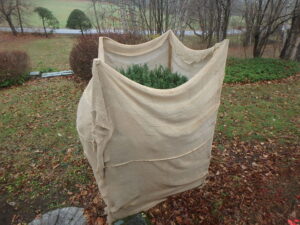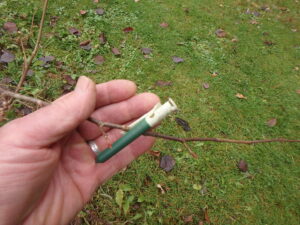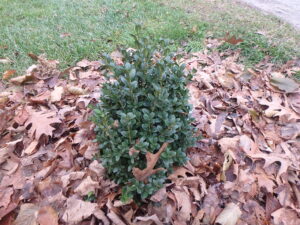Dealing with Deer
Posted on Tuesday, November 17, 2020 · Leave a Comment
Winter is near, and, for most of us, so are the deer. They need extra food now, to get ready for winter, and some of what they eat – green leaves and grasses– are not readily available. So they are eating evergreen plants like yew, arborvitae and rhododendrons in our yards. There are steps you can take to help save your shrubs.
What can you do? You’ve probably heard the solution, but might not like it: an eight-foot deer fence around the perimeter of your property. Even then you might get an occasional Olympic deer that can sail over it. But generally deer are kept out by such a fence.
You don’t have to have a steel fence – lightweight plastic fencing will work, too. And you can use poles to support the fencing, straight young tree trunks you cut yourself from the back forty. And you don’t have to fence your entire property. You could put up temporary fencing just for the winter around a tree or shrub that is particularly attractive to deer that has been browsed in the past.

Burlap can be used to keep deer away from tasty shrubs
Recently I helped set up barriers around a pair of large yew shrubs. The shrubs are about 6 feet tall and wide, and in past they have been stripped bare by deer. I got four 8-foot hardwood stakes and drove them into the ground around each shrub– I needed a stepladder and a 3-lb sledge to do it.
The widest burlap we could buy was 44 inches wide, so my wife Cindy sewed 2 strips together to make an extra wide band. We draped the cloth over the stakes, and stapled the cloth to the stakes – all the way to the ground. We did not cover the top of the shrub, just the sides, so snow will fall through and not weight down the cloth. It worked well last year – the poor deer went hungry.

Garlic clips work well for me to deter deer
What else? There are numerous repellents that work to a greater or lesser degree. I’ve had great luck using little garlic clips that I get from Gardener’s Supply Company. Each has a clothespin type clip to attach it to a shrub, and has little cylinder filled with garlic oil. When you poke the device with a tool they provide, it releases the odors for up to 6 months. I use 2 per shrub, or more for bigger things or more attractive deer food.
Coyote urine is sold as a deer repellent, too. It is sold with one-ounce plastic bottles that have holes in the sides, a hanger on top and a cotton ball in the bottom. Dribble a little of their magic potion on the cotton, and hang it in a tree. Of course, you can also just bring your dog around the property and let him mark trees and shrubs. Some people hang bars of Irish Spring soap to discourage deer.
There are numerous sprays, too. Bobbex, Deer Away, Liquid Fence and Plantskydd are some of the most commonly sold varieties. Most use rotten eggs, garlic, or fish oils. You might not want to spray your plants the day of a garden party, but most odors disappear to us after a few days. If deer pressure is high, you might want to alternate which one you use.
Deer are creatures of habit. If they know you have good browse, they will come. If they think you have a pet coyote, they will stay away. No dog? Get dog hair from your local pet groomer. Some people hang sachets containing human hair out in their yard, or hang bars of Irish Spring soap to repel the deer.
There are ways to scare deer away, too, but most take some effort to set up. You could install a motion detector attached to a radio with an all-talk radio format. When the deer arrive, Rush Limbaugh comes on and scares them away, I suppose. I’ve seen motion detectors that attach to a hose, and send out spray when deer are detected. That only works in summer, obviously.
In areas of high deer population, gardeners sometimes choose their plants based on their appeal to deer. People, Places and Plants magazine (Now, sadly, out of business) asked its readers to rate plants eaten by deer. They published the results in Issue #45 (summer, 2004). Here is some of what they said:

Boxwood are generally not eaten by deer
Seldom eaten shrubs include boxwood, dogwoods, forsythia, and spirea. Occasionally eaten shrubs include blueberry, hydrangeas, lilacs, summersweet clethra, and viburnums.
Trees rarely pruned by deer include birch and ginkgo. Their survey listed occasionally eaten trees as Japanese maple, pear, pine, magnolia, spruce, willow and crabapple. I raised an eyebrow when I saw crabapple, as I frequently see apple trees that have been browsed by deer. Crab apples, I assume would be the same, but please let me know if I’m wrong.
In areas with lots of deer, it makes sense to plant perennials that deer love near the house, and those eschewed by deer farther away. So hostas and tulips, loved by deer, should be right near the house. The survey found flowers usually eaten include lilies, daylilies, hollyhocks, black-eyed Susans, and asters. Scented things like lavender, artemesia and oregano are generally of little interest, and those seldom nibbled include balloon flower, bleeding heart, astillbe, foxgloves, columbine, peonies, Russian sage, yarrow and monkshood.
For a more complete list of deer preferences, you may want to consult a book on the issue. One I like is Outwitting Deer by Bill Adler Jr. But remember, if you have a plant that is dear to you, fence around it – there is almost nothing a hungry deer won’t eat.
Henry is the author of 4
gardening books. He is an organic
gardener and long time UNH Master
Gardener. You may reach him by e-mail at
henry.homeyer@comcast.net.





